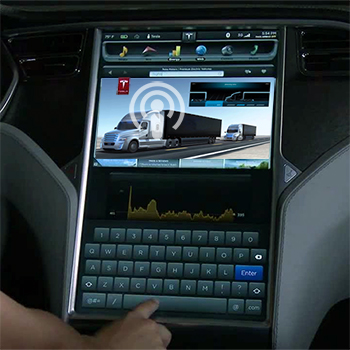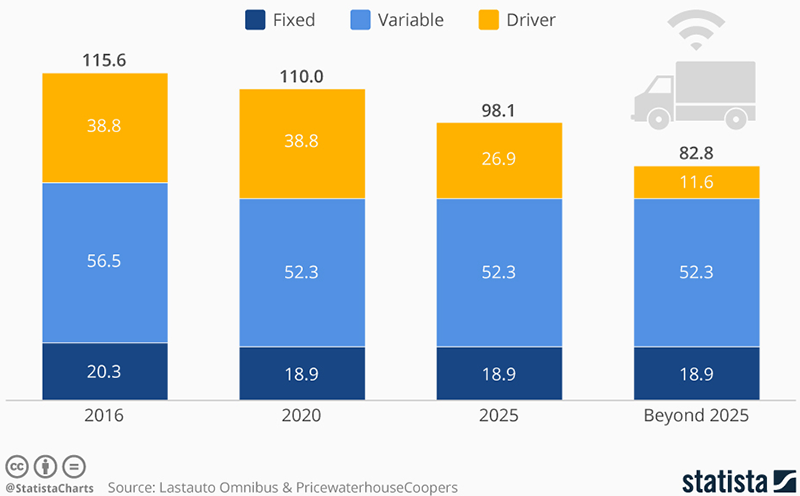Tesla CEO Elon Musk has been teasing an electric semi truck for a while now, ahead of an official unveiling this fall.
But a report in Reuters adds a new, if somewhat unsurprising, wrinkle to the mix: the Tesla big rig is probably going to have self-driving capabilities.
Reuters has seen emails between Tesla and the Nevada DMV where the two sides discussed “potential road tests” of the truck’s self-driving capabilities.
The information also apparently describes Tesla’s desire to create long-haul electric semis that can drive themselves in platoons,” potentially following behind a lead truck piloted by a human driver.
Read: $5 million for Truck Platooning Study
The idea that Tesla is working on incorporating self-driving technology into its upcoming semi truck falls in line with how aggressive the company has been at building the same tech into its consumer cars.
Tesla offers semi-autonomous features on all of its current models in the form of Autopilot, which costs an additional $5,000 at the time of purchase. It also offers a $3,000 full “self-driving” option, which the company says will be activated once the software is ready. (Tesla claims that all of its cars are already equipped with the hardware necessary for full autonomy.)
What is surprising is that Tesla appears ready to test this technology.
The state of Nevada is a likely partner, as it’s one of the few in the country that actually gives out licenses for autonomous vehicle testing. It was also the first state to allow self-driving big rigs to test in 2015 when Daimler acquired two AV licenses for its own Freightliner Inspiration Truck. Volvo is working on adding autonomous capabilities to its own trucking fleet, too.
Autonomy is also a common theme for the Silicon Valley companies that have dipped into the trucking world. In 2016, Uber acquired self-driving truck company Otto, which was led by a former high-profile employee of Google’s own self-driving project. (That employee is now currently at the center of a legal battle between Google’s parent company and Uber.) And Waymo, the company that blossomed out of Google’s self-driving car project, is working on its own self-driving truck program.
Tesla is planning an official reveal of the semi truck in September, so that’s when we’ll likely learn just how far the company wants to push this new part of its self-driving ambitions.
Autonomous Trucks Will Mean Big Savings For Freight Companies
Autonomous driving technologies are determining the future of the trucking industry. While the first tests for self-driving trucks under real conditions are underway, the entire absence of the driver is still far in the future.
Using data from the specialist magazine Lastauto Omnibus, a study by PwC suggests that by 2025, fleet owners could reduce their total costs by 15 percent compared to 2016 and even 28 percent beyond that year (considering the current annual operating costs of €115,600 for an average long-haul truck).
While fixed costs (such as gasoline) and variable costs (including tax, rates for cleaning, communication and testing costs) would be reduced by a mere 7 percent respectively, the highest potential for saving lies with the cost of a driver.
Accordingly, autonomous driving technologies are likely to reduce annual costs of a driver by staggering 30 percent by 2025 – an incentive that makes self-driving trucks a hot prospect for freight companies.
However, from the perspective of drivers employed at freight companies, this is bad news: Goldman Sachs estimated that the new technology could eliminate 25,000 driver jobs a month or 300,000 per year about 25 years from now.
Read the Article: While No Cure-All, Possibility of Driverless Trucks Offers Hope for Truck Driver Crisis
Autonomous Truck: Big Savings For Freight Companies?
Average annual operating costs per long-haul truck (in thousand euros)
Related Article: Trucking Tech Getting Serious Investor Interest
Related White Papers
2017 Commercial Transportation Trends
As the transportation and logistics industry morphs, traditional rivals will no longer be the sole or even the most threatening competition, incumbents must adapt to keep up with their customers. Download Now!
The Era of Digitized Trucking: Transforming the Logistics Value Chain
The promise of connected trucks combined with the digital supply chain is huge, but so are the risks for those players that don’t move now to begin building the capabilities and business models needed to win in this new world. Download Now!
Article topics
Email Sign Up




















